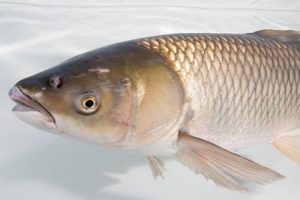A graduate student at The University of Toledo is the first researcher to find direct proof of grass carp, a type of invasive Asian carp, spawning in a Great Lakes tributary.
Holly Embke collected eight grass carp eggs last summer in the Sandusky River in Ohio, which flows into Lake Erie. She discovered the eggs between Fremont, Ohio, and Lake Erie’s Sandusky Bay after a period of heavy rains.
The fish eggs, which were confirmed through DNA testing, mark the first direct evidence of the invasive species reproducing in the Great Lakes basin.
Embke’s paper is published in the Journal of Great Lakes Research. Embke will also make a presentation of this work at the annual conference of the International Association for Great Lakes Research on June 9 at the University of Guelph, Ontario.
This research was conducted as a follow-up to U.S. Geological Survey findings in 2013 that indicated four young grass carp taken from the Sandusky River were the result of natural reproduction.
“Lake Erie commercial fishermen have reported catching grass carp since the mid-1980s, but those catches were thought to be sterile escapees from ponds and small lakes that were legally stocked for aquatic weed control,” said Embke, who is pursuing a master’s degree in biology in the Department of Environmental Sciences. “The discovery of these eggs in the Sandusky River means that this invasive species of Asian carp, which consumes large amounts of freshwater vegetation, is naturally reproducing in our Lake Erie watershed.”
Although considered a species of Asian carp, wild adult grass carp pose significantly different risks to the Lake Erie ecosystem than bighead carp and silver carp, which are the two invasive Asian carp species of great concern in the Mississippi River basin. Silver carp are well-known for their jumping ability.
Grass carp pose a risk to waterfowl habitat and wetlands, but they do not eat plankton and are unlikely to compete directly with native fish. Grass carp do not jump and are primarily herbivorous. They can alter habitats for native fish communities near the shoreline by eating submerged, rooted plants and weeds.
Scientists with UT, the Ohio Department of Natural Resources (ODNR) Division of Wildlife and the USGS are collecting additional samples from the Sandusky River to continue studying the habitat requirements of grass carp spawning in order to inform methods for control of all invasive species of Asian carp.
Sterile grass carp can be legally stocked in Ohio, as well as Indiana, Illinois, New York, and Pennsylvania. They are a popular pond and small lake management tool because they control aquatic weeds.
Ohio has banned the stocking of fertile grass carp and Michigan has banned all grass carp. The fish was first imported to the U.S. from Taiwan and Malaysia in 1963.
source: U.S. Geological Survey
